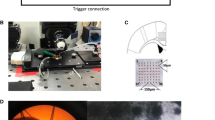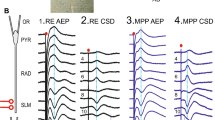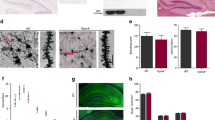Abstract
The transient receptor potential vanilloid 1 (TRPV1) channel is a non-selective cation channel that is mainly found in nociceptive neurons of the peripheral nervous system; however, these channels have also been located within the CNS, including the entorhinal cortex. Whole-cell patch-clamp recordings of principal entorhinal cortex (EC) layers II/III neurons revealed that evoked inhibitory postsynaptic currents were depressed by application of the TRPV1 agonist capsaicin (CAP), accompanied by a change in the pair-pulse ratio (PPR). In addition, recordings of miniature inhibitory postsynaptic currents (mIPSCs) revealed that inter-event intervals but not amplitude were decreased in wild-type (WT) after application of CAP. This suggests that TRPV1 channels are functional in the entorhinal cortex and are located on inhibitory neurons with their axonal arborization within layers II/III. In order to study TRPV1 channels and their involvement in long-term potentiation (LTP) induction in a more intact circuit, extracellular field potential recordings were performed in EC layers II/III. It was found that activated TRPV1 channels preclude induction of long-term potentiation. In sharp contrast, clear LTP was observed when antagonizing TRPV1 channels or recording from TRPV1 knock-out mice. Thus, these results suggests that signaling through activating inhibitory presynaptic TRPV1 channels represents a novel mechanism by which a shift in feed-forward inhibition of layers II/III cortical principal neurons prompt changes in synaptic strength and thereby contribute to a change of information storage within the brain.








Similar content being viewed by others
References
Bear F, Kirkwood A (1993) Neocortical long-term potentiation. Curr Biol 3:197–202
Bennion D, Jensen T, Walther C, Hamblin J, Wallmann A, Couch J, Blickenstaff J, Castle M, Dean L, Beckstead S, Merrill C, Muir C, St Pierre T, Williams B, Daniel S, Edwards JG (2011) Transient receptor potential vanilloid 1 agonists modulate hippocampal CA1 LTP via the GABAergic system. Neuropharmacology 61:730–738. doi:10.1016/j.neuropharm.2011.05.018
Brown TE, Chirila AM, Schrank BR, Kauer JA (2013) Loss of interneuron LTD and attenuated pyramidal cell LTP in Trpv1 and Trpv3 KO mice. Hippocampus 23:662–671. doi:10.1002/hipo.22125
Cavanaugh DJ, Chesler AT, Jackson AC, Sigal YM, Yamanaka H, Grant R, O’Donnell D, Nicoll RA, Shah NM, Julius D, Basbaum AI (2011) Trpv1 reporter mice reveal highly restricted brain distribution and functional expression in arteriolar smooth muscle cells. J Neurosci 31:5067–5077. doi:10.1523/JNEUROSCI.6451-10.2011
Chávez AE, Chiu CQ, Castillo PE (2010) TRPV1 activation by endogenous anandamide triggers postsynaptic long-term depression in dentate gyrus. Nat Neurosci 13:1511–1518. doi:10.1038/nn.2684
DeFelipe J (1997) Types of neurons, synaptic connections and chemical characteristics of cells immunoreactive for calbindin-D28K, parvalbumin and calretinin in the neocortex. J Chem Neuroanat 14:1–19. doi:10.1016/S0891-0618(97)10013-8
Doyle MW, Bailey TW, Jin Y-H, Andresen MC (2002) Vanilloid receptors presynaptically modulate cranial visceral afferent synaptic transmission in nucleus tractus solitarius. J Neurosci 22:8222–8229
Gibson HE, Edwards JG, Page RS, Van Hook MJ, Kauer JA (2008) TRPV1 activation by endogenous anandamide triggers postsynaptic long-term depression in dentate gyrus. Neuron 57:746–759. doi:10.1016/j.neuron.2007.12.027
Grueter BA, Brasnjo G, Malenka RC (2010) Postsynaptic TRPV1 triggers cell type-specific long-term depression in the nucleus accumbens. Nat Neurosci 13:1519–1525. doi:10.1038/nn.2685
Kaneko Y, Szallasi A (2014) Transient receptor potential (TRP) channels: a clinical perspective. Br J Pharmacol 171:2474–2507. doi:10.1111/bph.12414
Kauer JA, Gibson HE (2009) Hot flash: TRPV channels in the brain. Trends Neurosci 32:215–224. doi:10.1016/j.tins.2008.12.006
Kawaguchi Y, Kubota Y (1997) GABAergic cell subtypes and their synaptic connections in rat frontal cortex. Cereb Cortex 7:476–486
Kirkwood A, Bear MF (1994) Hebbian synapses in visual cortex. J Neurosci 14:1634–1645
Kirkwood A, Dudek SM, Gold JT, Aizenman CD, Bear MF (1993) Common forms of synaptic plasticity in the hippocampus and neocortex in vitro. Science 260:1518–1521
Li H-B, Mao R-R, Zhang J-C, Yang Y, Cao J, Xu L (2008) Antistress effect of TRPV1 channel on synaptic plasticity and spatial memory. Biol Psychiatry 64:286–292. doi:10.1016/j.biopsych.2008.02.020
Maione S, Cristino L, Migliozzi AL, Georgiou AL, Starowicz K, Salt TE, Di Marzo V (2009) TRPV1 channels control synaptic plasticity in the developing superior colliculus. J Physiol 587:2521–2535. doi:10.1113/jphysiol.2009.171900
Malenka RC, Bear MF (2004) LTP and LTD: an embarrassment of riches. Neuron 44:5–21. doi:10.1016/j.neuron.2004.09.012
Malenka RC, Nicoll RA (1999) Long-term potentiation—a decade of progress? Science 285:1870–1874
Marinelli S, Vaughan CW, Christie MJ, Connor M (2002) Capsaicin activation of glutamatergic synaptic transmission in the rat locus coeruleus in vitro. J Physiol 543:531–540. doi:10.1113/jphysiol.2002.022863
Markram H, Toledo-Rodriguez M, Wang Y, Gupta A, Silberberg G, Wu C (2004) Interneurons of the neocortical inhibitory system. Nat Rev Neurosci 5:793–807. doi:10.1038/nrn1519
Marsch R, Foeller E, Rammes G, Bunck M, Kössl M, Holsboer F, Zieglgänsberger W, Landgraf R, Lutz B, Wotjak CT (2007) Reduced anxiety, conditioned fear, and hippocampal long-term potentiation in transient receptor potential vanilloid type 1 receptor-deficient mice. J Neurosci 27:832–839. doi:10.1523/JNEUROSCI.3303-06.2007
Monaghan D, Cotman W (1985) Distribution of N-methyl-D-aspartate-sensitive binding sites in rat brain. J Neurosci 5:2909–2919
Motter AL, Ahern GP (2008) TRPV1-null mice are protected from diet-induced obesity. FEBS Lett 582:2257–2262. doi:10.1016/j.febslet.2008.05.021
Musella A, De Chiara V, Rossi S, Prosperetti C, Bernardi G, Maccarrone M, Centonze D (2009) TRPV1 channels facilitate glutamate transmission in the striatum. Mol Cell Neurosci 40:89–97. doi:10.1016/j.mcn.2008.09.001
Peters JH, McDougall SJ, Fawley JA, Smith SM, Andresen MC (2010) Primary afferent activation of thermosensitive TRPV1 triggers asynchronous glutamate release at central neurons. Neuron 65:657–669. doi:10.1016/j.neuron.2010.02.017
Riera CE, Huising MO, Follett P, Leblanc M, Halloran J, Van Andel R, de Magalhaes Filho CD, Merkwirth C, Dillin A (2014) TRPV1 pain receptors regulate longevity and metabolism by neuropeptide signaling. Cell 157:1023–1036. doi:10.1016/j.cell.2014.03.051
Sasamura T, Sasaki M (1998) Glutamatergic terminals., pp 2045–2048
Squire LR, Stark CEL, Clark RE (2004) The medial temporal lobe. Annu Rev Neurosci 27:279–306. doi:10.1146/annurev.neuro.27.070203.144130
Yang K, Kumamoto E, Furue H, Yoshimura M (1998) Capsaicin facilitates excitatory but not inhibitory synaptic transmission in substantia gelatinosa of the rat spinal cord. Neurosci Lett 255:135–138
Acknowledgement
This work was supported by the Lundbeck Foundation and the Carlsberg Foundation.
Author information
Authors and Affiliations
Corresponding author
Rights and permissions
About this article
Cite this article
Banke, T.G. Inhibition of TRPV1 channels enables long-term potentiation in the entorhinal cortex. Pflugers Arch - Eur J Physiol 468, 717–726 (2016). https://doi.org/10.1007/s00424-015-1775-4
Received:
Revised:
Accepted:
Published:
Issue Date:
DOI: https://doi.org/10.1007/s00424-015-1775-4




